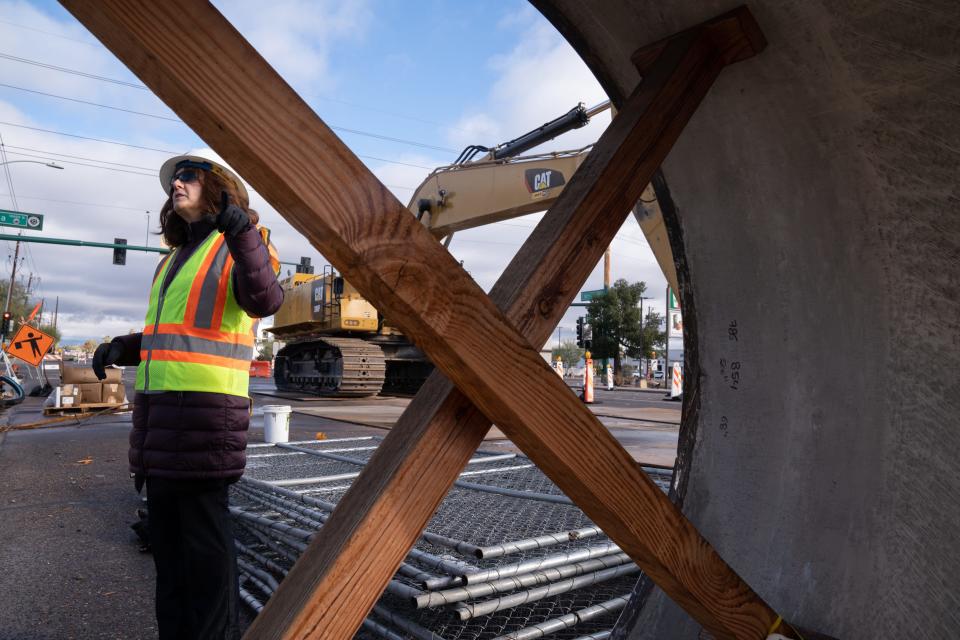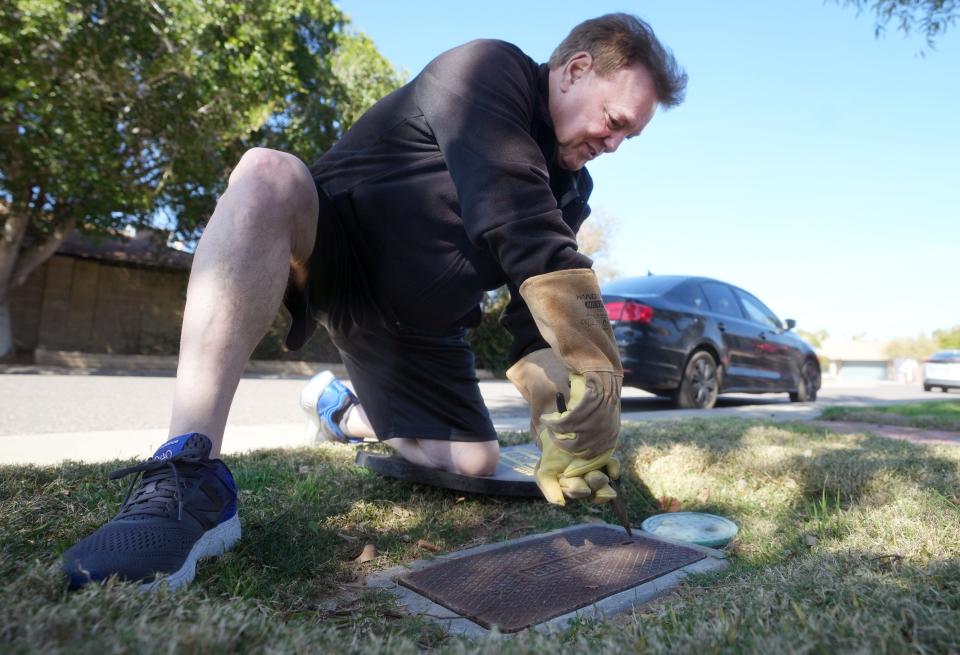The water from leaky pipes in Phoenix could supply a small city, but there's no cheap fix
Like a lot of homeowners in neighborhoods with decades-old plumbing, Ken Hoag experienced a leak in the pipe leading under his yard from the curbside city meter to his house. Only this was no trickling stream, but a gusher that would cost him more than $1,000.
City meter readers must check meters manually or, at homes with updated meters, they must at least drive through the neighborhood for it to ping their equipment with current water volumes.
In Hoag’s case last fall, that took long enough that no one from the city alerted him of unusual readings until 160,000 gallons had drained away under his yard over parts of two billing cycles. He hadn’t noticed so much as a puddle to suggest a problem and was shocked when he got the first of those bills on Nov. 22.
“If I’m just one person wasting 160,000 gallons, how many other people across the Valley is this happening to?” Hoag said.
It's a good question, and one that reveals a challenge the city faces in squeezing every drop it can from a drought-stressed supply.
The answer isn’t clear. Phoenix Water Services tracks the water that escapes its own pipes, and it amounts to about 9% of what it supplies to residents and businesses day in and day out. But the department could not provide numbers for losses beyond its meters, where property owners are responsible and must pay for water regardless of whether they actually meant to use it.
Hoag gets that, and he’s on a payment plan that will allow him to take a year to make good on his unexpected expense. What he doesn’t understand is why the city doesn’t have a 21st century technology to alert homeowners when something’s not right with their meter.
“There has to be some technology that the city of Phoenix could have that would tell the homeowner that they have a leak in their ground,” Hoag said. “They’re running all these drought ads” encouraging residents to conserve. “All this water from all these leaks across the Valley are going into the ground, thousands and thousands of gallons, and they’re not concerned about that?”
In fact, they say they are concerned, and they are hoping to do something about it. It’s just really expensive and is going to take time.
Phoenix is seeking a $90 million grant from the U.S. Bureau of Reclamation WaterSmart program to install the type of wireless-connected meters that could alert customers daily if their water use spikes unusually, Water Services Director Troy Hayes said.
“That’s where the utilities need to move toward,” he said. “Our customers want it.”
Reclamation is the agency that manages the Colorado River dams that store a critical and shrinking share of Arizona’s water supply. Its grants are meant to help shore up that supply by reducing water demand or waste.
Stretching supplies: How Colorado River cities are preparing for shortages with conservation and alternate sources
In Austin, smart meters caught a sneaky cat
Austin, Texas, has built out a smart-meter system over the last few years with the ability to rapidly alert customers to problems. Its experience shows what’s possible, while also suggesting that Phoenix might need to invest more than the $90 million it’s seeking to do the same.
Starting in 2020, Austin began replacing its 255,000 meters with new devices equipped to transmit data directly to the water department. It also built an online portal where customers can set up email or text alerts based on their individual goals.
As a baseline, the system alerts users whose water consumption spikes, said Randi Jenkins, Austin Water’s assistant director of customer experience.
“If it’s seeing more than 7 gallons a minute being used over multiple hours, the system says, ‘Hey, we think that’s a leak,’” Jenkins said. It can alert the customer every six hours unless they disable the alerts because their water use is intentional or expected. Larger leaks, as from a burst pipe, trigger more immediate alerts.
In one case, Jenkins said, a smart meter helped an Austin couple learn that their cat was wasting water while they were away. It alerted them to recurring nighttime spikes in use that their cat sitter couldn’t explain until they reviewed home security video and saw the cat turn on a tap and leave it running.
Austin, like Phoenix, uses tiered water rates that charge more per gallon as customers move past basic household culinary and hygiene needs into water-intensive demands such as filling a pool or irrigating a lawn. If Austin customers want, Jenkins said, they can request alerts whenever they are about to tip into a new rate tier.
Also like Phoenix, Austin is in a high-growth region where the climate is warming and future water security is a priority.
“Every day that goes by we’re saying, ‘How do we make sure that there’s water for the next 100 years?'” Jenkins said.
The upgrade is nearing completion, with about 200,000 meters installed and 55,000 to go, and will wind up costing $103 million, Jenkins said. Austin is using impact fees on new developments to pay it off.
If you subscribe, you'll know: Why is Arizona's hard water a problem? It's in the latest edition of AZ Climate, The Republic's environment newsletter.
'The true price of sprawl'

Phoenix has more than 430,000 meters, likely meaning a costlier road to real-time alerts. The city is investing in both supply and demand solutions, Hayes said. “It’s all a part of the overall strategy to ensure a sustainable system.”
For instance, the city is investing in Salt River Project's plan to add storage capacity at Bartlett Dam, while also spending some $45 million a year in pipe replacements to cut down on roughly 28,000 acre-feet of losses from its 7,000 miles of distribution lines.
Those kinds of losses, in the range of 9%, have held steady for years.
“That’s enough for a small city,” said Kathryn Sorensen, director of research at Arizona State University’s Kyl Center for Water Policy. “It’s a lot of water that’s lost to leaky pipes.”
Sorensen directed Phoenix’s water department when it financed $1.5 billion in improvements. Some of that went to a new water main moving Salt River supplies north to ensure continued deliveries into north Phoenix as Colorado River flows become less dependable. Most was earmarked to replace “damned old” pipes that leak. Eventually, she said, the city will have to revisit funding for pipe replacements.
“It never ends,” she said.
Phoenix serves water across its 517 square miles and then some, stretching the distances where leaks can hide and making upgrades more challenging and expensive.
“Whatever we’re investing now is not enough,” Sorensen said. “That will be the true price of sprawl.”
“You’re always going to have losses in the system,” Hayes said, “but as the Colorado River continues to have issues, we have to attack this on both the supply side and the demand side. (Smart meters are) a way to fix part of the demand side.”
Over the next few years, he said, the city hopes to add meters throughout the city that enable at least monthly alerts of potential leaks to customers before they get their bills. The goal is a system to allow real-time alerts, he said, but that could take longer.

Meantime, Hoag has become a diligent inspector of his own meter. In the weeks after a plumber fixed the leak, Hoag, who is 74, got on his knees daily to lift the in-ground meter’s lid and make sure its numbers weren’t spinning rapidly. So far so good, and he said he’s only checking occasionally now.
He advises his neighbors throughout the city to do the same.
“It just leaks into the ground,” he said, “and if you don’t see anything, then you don’t know you have a leak.”
Underway: Glendale's overhaul of its water metering system could bring more revenue, help users save water
Brandon Loomis covers environmental and climate issues for The Arizona Republic and azcentral.com. Reach him at brandon.loomis@arizonarepublic.com.
Environmental coverage on azcentral.com and in The Arizona Republic is supported by a grant from the Nina Mason Pulliam Charitable Trust. Sign up for AZ Climate, our weekly environment newsletter, and follow The Republic environmental reporting team at environment.azcentral.com and @azcenvironment on Facebook and Instagram.
You can support environmental journalism in Arizona by subscribing to azcentral.com today.
This article originally appeared on Arizona Republic: A Phoenix resident missed a big water leak. Could smart meters help?

